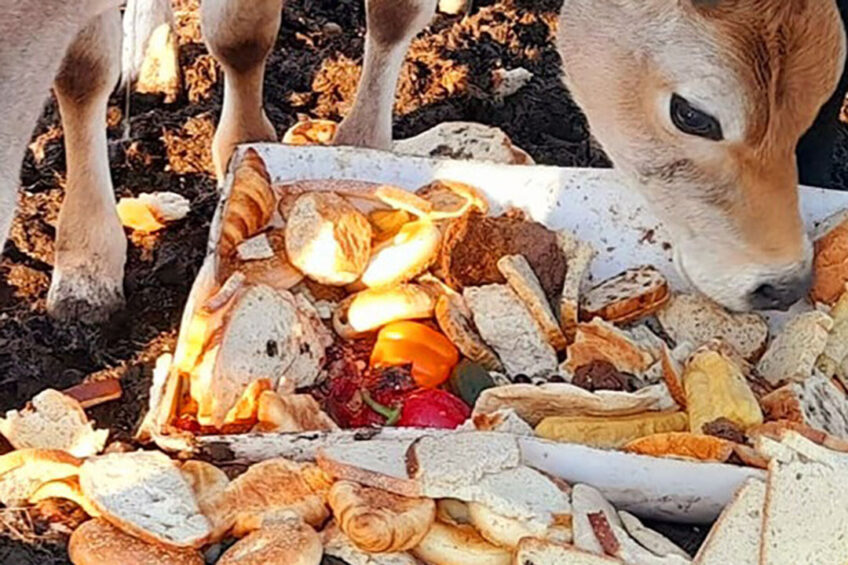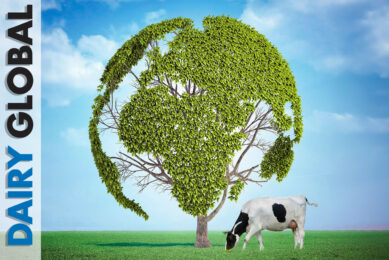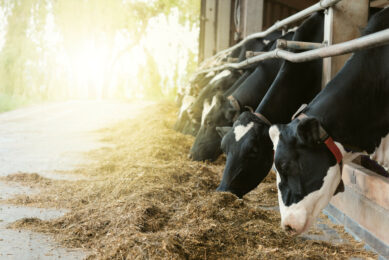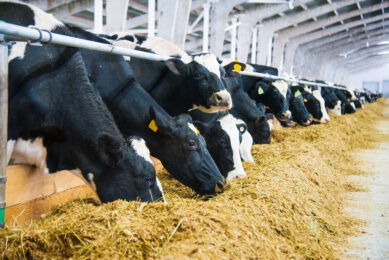From the US to India and turning food waste into milk

Continued strides are being made around the world to ensure human food waste and food processing by-products are not sent to landfills or incinerated but converted back into nutritious products by dairy cattle. From the US to India, we look deeper into food waste as cow nutrition.
Every industry on Earth is being encouraged these days to reduce its carbon footprint and do more with less. The global dairy industry has been active in this sphere for quite some time in several ways. One of them is through using extensive amounts of food waste and food processing by-products in feed.
According to a joint study published in 2019 by researchers at Kansas State and other US universities, rations for dairy cattle in North America at that point contained 20% to 30% food processing by-products. “Studies have demonstrated that diets with relatively high proportions of by-products can maintain or even improve ruminant performance,” state the authors. “Dairy cows fed by-products in place of cereals and pulses had similar dry matter intake and milk yield compared with cows fed conventional diets.”
According to Darigold, the marketing arm of the Northwest Dairy Association, dairy cows in the US consume about 306 million pounds of food waste daily. The association points to a study done at University of Wisconsin-Madison in 2015 which identified up to 41 different sources of waste and by-products, including bakery waste, sweet corn cannery waste, vegetable trimmings, and much more (box), being fed to dairy cattle in the US Midwest. Indeed, some by-products, such as dried distillers grains, are now considered a common dairy cow feed component.
The California Dairy Research Foundations states that dairy cow diets in that state can contain up to 40% food by-products such as almond hulls. Washington State’s 262,000 dairy cows consume 5.4 million pounds of by-products every day. “Dairy farmers in [Washington] have utilised by-products that would otherwise end up in landfills for a long time and they are common on most dairies,” explains Kimmi Devaney, director of communications at the Dairy Farmers of Washington. “The exact byproduct feeds used depends on what is available in the area.”
Devany points to a dairy in Enumclaw, WA that uses brewers grain and bakery waste, for example, and another near Royal City that uses potatoes rejected from food service and other vegetables unsuitable for grocery store sales. Other food waste used as feed in Washington includes apple processing waste and cottonseed.
Expert opinion: Sustainable dairy farming, the bigger picture
If you were to describe the future of agriculture in one word, what would that word be? Many would choose the word ‘sustainable’. The global consumer-lead sustainability movement has brought real changes in science, practice, and policy, but what does it mean for the dairy nutritionist? Find out more…
India
In India, according to Dr Kumarasamy Murugesan of the Department of Environmental Science at Periyar University, most food waste generated in rural areas is already consumed by dairy cattle and other livestock. Dairy farming remains a very important economic activity all over the country.
Use of food waste is organised in an informal and small-scale way. Cattle are also fed food processing waste such as rice bran, oil cake from nuts and sago starch, and some feed companies use these ingredients as well.
Due to high prices and a limited supply of conventional raw feed materials in India, there is currently great interest among farmers in alternatives to these materials, including more use of food waste and by-products. Murugesan points to a start-up company in India that is expanding its sales of food waste-based cattle feed for dairy cattle. The company dehydrates food waste in a controlled environment. In addition, scientists at Guru Angad Dev Veterinary and Animal Sciences University have also developed ways to recycle food waste into animal feed.

As in other countries, food wastage in India, says Murugesan is happening at every level. To progress with the use of food waste as animal feed, he says “detailed survey studies and analysis are necessary, on the availability, seasonal variation, nature, types, quantity and quality of food waste, cost of collection, segregation and transportation.”
Country report: India’s dairy sector remains strong and steady
India is one of the major producers of milk in the world and while its population accounts for most of the consumption of the nation’s produce, there is no doubt that production is standing strong with a steady growth in the volume over the years. Read more…
Canada
In Canada, a program called Loop that connects livestock farmers with grocery stores to use food waste as feed is getting larger every year. It now includes 207 stores and 1650 farms (it’s unknown how many are dairy farms) and Loop founder Jaime White says the program may span all the way to the east coast by the end of this year.
The program has many parts, from educating farmers, following up on any issues and checking in with the Canadian Food Inspection Agency (CFIA) to make sure the program is compliant with feed regulations. Education of grocery store workers is also important to ensure waste from various store departments is placed only in designated department bins to keep various types of waste separate.
“We have very low instances of contamination,” says White. “In some other places in the world that’s a problem, but we’ve been very successful with developing training and managing ongoing operations to mitigate that. The legalities have been the most important biggest challenge, mitigating legal risks for both producer and provider of the goods have been the biggest challenges. Producers need to make sure they comply with CFIA guidelines. A well-run program ensures this is possible.”
In addition, scientists from the University of Manitoba, University of Lethbridge (in Alberta) and Agriculture & Agri-food Canada have been studying how livestock (particularly beef cattle) can use food waste. The federal government has also launched the ‘Food Waste Reduction Challenge’ which will award more than CAN$10 million in prizes for innovative solutions to reducing food waste, part of Canada’s commitment to the United Nations’ goal to reduce food waste 50% by 2030.
Farm report, Canada: Leaving the supply management system
Milk processing on the farm is not so common in Canada as dairy farmers there have relied on the trusted supply management system to market their milk. However, that system has been heavily tested in recent years. Check it out…
Europe
In Europe right now, an update to regulations regarding using food waste as feed is urgently hoped for by the European Dairy Association (EDA).
EDA Director of Food, Environment & Health Hélène Simonin-Rosenheimer notes that barriers to the use of food waste in dairy cattle feed are currently high due to serious food and feed safety concerns in the past with use of food waste as feed. However, she says nowadays, many food waste materials that can be used for dairy cow feed (and dairy processing by-products that could be used to feed other livestock) that have been discarded in the past can now be re-used.
“The current legislation often hinders a practical approach,” says Simonin-Rosenheimer. “We would suggest that all authorities involved work on a ‘total chain approach’ aiming to fulfill food and feed safety and taking into account circular economy requirements.”
Country report: Dutch dairy facts, figures, farm trends
Here we offer an overview of the Dutch dairy industry, look at trade and consumption, and zoom in on the sector’s focus on sustainability. Find out more…
She observes that the existing legislative framework would need to be made up-to-date to respond to the increased ambition of institutions, industry, citizens, and other stakeholders towards further food waste prevention and reduction. “In this context,” she explains, “if and when the legislators will revise the current legislative framework (currently, only the feed additives legislation is being reviewed), ensuring the coherence with the Green Deal and objectives of the Circular Economy Action Plan would be of the utmost importance.” (See the EDA Position Paper on former foodstuff guidelines and other resources.)
Figure – In terms of total US waste, non-profit organisation ReFED notes that across the US in 2019, 35% of all edible food went used, a total value of US$408 billion and equating to 4% of total US greenhouse gas emissions. Here is a breakdown from ReFED.

Moving forward
While food waste and food processing by-products are used to feed dairy cattle in limited ways in probably all parts of the world, momentum is building for more widespread use. This circularity makes not just dairy farming, but our entire food system, more sustainable.
To use food waste effectively, dairy farmers and other livestock farmers require safe ingredients and a stable, steady supply. Experts recommend that food waste be mixed thoroughly with the rest of dairy cattle feed to ensure a uniform intake.
High moisture materials like vegetable waste may seem like a bargain but can be expensive on a dry matter basis, so farmers need to do their homework. Farmers also need to manage situations where their cows may get used to having sweet food waste in their feed and due to supply issues or other issues, they cannot have it anymore. Different levels of different food waste materials can be fed to different cow types in a herd, such as milking cows and heifers.
Above all, farmers should seek the advice of their nutritionists to ensure balanced rations and build good relationships with the companies that supply can supply food waste feed ingredients.
Webinar on demand: Improving sustainability, profitability in milk production
The recent webinar ‘Improving Sustainability and Profitability of Milk Production’ which took place on 11 June 2021, presented great insights into efficiency and how it impacts health and performance of dairy cows. Check out this exciting webinar…
Phil Pittolo, a livestock nutritionist in Bego, New South Wales, Australia, says that in that country, direct relationships between farmers and food processors/grocery stores in that country have developed over time.
“These [food waste] feeds are opportunistic,” he says. “If the farmer or their nutritionists understands the characteristics and value of a given feed, and it is delivered in a physical form and packaging that suits the farm, it will be used.”
Nutritional value of various food waste ingredients for dairy cows, summarised from ‘By-Product Feedstuffs in Dairy Cattle Diets in the Upper Midwest’ (2015) by Dr Randy Shaver, professor and extension dairy nutritionist at the University of Wisconsin –Madison, US:
Beet Pulp
• may be fed dry or wet
• upper feeding limit: about half of the grain concentrate or 8-15lb of dry matter (DM) per cow per day
Brewers Dried Grains (BDG)
• commonly used as a protein source
• highly palatable
• generally limited to less than half of protein supplements and 25% of complete feeds; 5-lb DM per cow per day.
Soybean mill feed
• protein, fiber and fat content can vary
• can contain a high percentage of weed seeds
• restricted to 5-10 lb per cow per day because of high fat content
Bakery wastes
• stale bread and other pastry products can be fed to dairy cattle, but only in limited amounts.
• the high starch content will depress milk fat if fed beyond limits
• limit for dried bread is 20% of concentrate DM and 10% of TMR DM, but higher levels may be fed to replacement heifers and dry cows.
Cull dried beans or peas
• may comprise up to 15-20% of concentrate DM or 7-10% of TMR DM
• limits are due to palatability and protein quality restrictions
Candy
• may be high in sugar and/or fat content
• feeding rate of high-sugar candies should be limited to 2-4lb per cow per day
Vegetable trimmings
• usually fed fresh but sometimes are ensiled mixed with other forages
• should be treated like wet (85-95% moisture) forages when formulating rations because of their large particle size, high ash content and estimated energy content (0.62-0.68 Mcal NEl/lb of DM)
Join 13,000+ subscribers
Subscribe to our newsletter to stay updated about all the need-to-know content in the dairy sector, two times a week.










